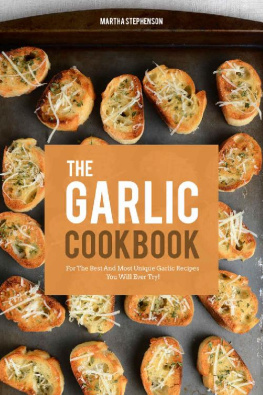ONIONS AND GARLIC

Edible
Series Editor: Andrew F. Smith
EDIBLE is a revolutionary series of books dedicated to food and drink that explores the rich history of cuisine. Each book reveals the global history and culture of one type of food or beverage.
Already published
Apple Erika Janik Banana Lorna Piatti-Farnell
Barbecue Jonathan Deutsch and Megan J. Elias
Beef Lorna Piatti-Farnell Beer Gavin D. Smith
Brandy Becky Sue Epstein Bread William Rubel
Cake Nicola Humble Caviar Nichola Fletcher
Champagne Becky Sue Epstein Cheese Andrew Dalby
Chocolate Sarah Moss and Alexander Badenoch
Cocktails Joseph M. Carlin Curry Colleen Taylor Sen
Dates Nawal Nasrallah Doughnut Heather Delancey Hunwick
Dumplings Barbara Gallani Eggs Diane Toops
Fats Michelle Phillipov Figs David C. Sutton
Game Paula Young Lee Gin Lesley Jacobs Solmonson
Hamburger Andrew F. Smith Herbs Gary Allen
Hot Dog Bruce Kraig Ice Cream Laura B. Weiss
Lamb Brian Yarvin Lemon Toby Sonneman
Lobster Elisabeth Townsend Melon Sylvia Lovegren
Milk Hannah Velten Mushroom Cynthia D. Bertelsen
Nuts Ken Albala Offal Nina Edwards Olive Fabrizia Lanza
Onions and Garlic Martha Jay Oranges Clarissa Hyman
Pancake Ken Albala Pie Janet Clarkson
Pineapple Kaori O Connor Pizza Carol Helstosky
Pork Katharine M. Rogers Potato Andrew F. Smith
Pudding Jeri Quinzio Rice Renee Marton Rum Richard Foss
Salmon Nicolaas Mink Sandwich Bee Wilson
Sauces Maryann Tebben Sausage Gary Allen Soup Janet Clarkson
Spices Fred Czarra Sugar Andrew F. Smith Tea Helen Saberi
Tequila Ian Williams Truffle Zachary Nowak
Vodka Patricia Herlihy Water Ian Miller
Whiskey Kevin R. Kosar Wine Marc Millon
Onions and Garlic
A Global History
Martha Jay
REAKTION BOOKS
Published by Reaktion Books Ltd
Unit 32, Waterside
4448, Wharf Road
London N1 7UX, UK
www.reaktionbooks.co.uk
First published 2016
Copyright Martha Jay 2016
All rights reserved
No part of this publication may be reproduced, stored in a retrieval system, or transmitted, in any form or by any means, electronic, mechanical, photocopying, recording or otherwise, without the prior permission of the publishers
Page references in the Photo Acknowledgements and
Index match the printed edition of this book.
Printed and bound in China by 1010 Printing International Ltd
A catalogue record for this book is available from the British Library
eISBN 9781780236209
Contents

Introduction

When the Devils left foot touched soil outside the Garden of Eden, garlic sprang up, and his right gave rise to onions.
Islamic proverb
From the silky slipperiness of a chopped onion in a soup to the perfume of garlic in a tomato sauce, onions and garlic seem to be an integral part of cooking. Theyre the vegetables I reach for the most often; hardly a day goes by that I do not chop an onion to throw into a soup or sauce, or crush some garlic to add to pasta or a dish of stir-fried vegetables. Yet they are rarely the stars of the show. Although they have a fair claim to be the most eaten foodstuff in the world according to the UN, 175 countries around the world produce an onion crop, far more than grow wheat countless recipe books warn against letting the natural pungency of onions or garlic overwhelm the other ingredients of a dish for fear of giving diners the dreaded onion breath.
But the story of the humble onion, ever present but unsung, goes far beyond food. As I delved further into onion lore, I discovered that its history also includes folklore, science and art. Why do onions make us cry, and can we do anything about it? Why do they say that garlic will protect us from vampires? How do you use onions to predict the weather? Does taking garlic pills mean that well avoid heart disease? And who brought the leek to Wales? Theyve entered the lexicons of many languages, too; from the English know your onions to the French soccuper ses oignons, meaning to look after ones own onions; in other words, to mind ones own business. A forgetful person in Portugal is a cabea dalho xoxo, or head of rotten garlic; in China, chicken feathers and garlic skin is a phrase used to describe things that are worthless, since they are the inedible bits left over from preparing a meal; and in Japan, a duck that comes bearing green onions is a phrase used to describe something thats proved unexpectedly useful or fortunate.
Garlic, leeks, chives, onions, spring onions (scallions) and shallots all taste slightly different, but they are all members of the same family the allium family which has been a friend to mankind since the earliest times. In their almost infinite variety, they have spread across the world, adding sweetness and pungency to dishes ranging from French onion soup to hamburgers to Korean pickled garlic.

Onion market in Khartoum, Sudan, 1936.

Office of War Information poster, UK, 19415.
The onion is one of the oldest domesticated vegetables in existence. Humans were probably eating onions even before they ate grain: wild allium varieties have been foraged since ancient times. As humans began to eschew the nomadic life and become settlers, we started to practise agriculture by selecting edible plants from the wild and transferring them to plots in order to cultivate and harvest them. Traces of alliums have been found in the remains of Bronze Age settlements, though its not clear whether these were domesticated types. Early farmers selected the plants that formed the largest, quickest-growing bulbs, and as these plants fertilized one another in their plots, plants more and more like our modern onion, with its large, sweet bulb, were developed. In this way, in Central Asia, the domesticated onion, which we now know by the Latin binomial Allium cepa, was born and it soon began to spread. At first it was brought to the Middle East by traders, and from there it made its way across the world.
There are between 500 and 650 varieties of allium worldwide, including ornamental varieties. Of these, there are seven major species of edible allium crop, the most common of which in the West is probably A. cepa (cepa is Latin for onion, and from it are derived the Spanish cebolla and the Polish cibula, among others). This is the large-bulbed kind of allium, the kind we would familiarly call onion rather than garlic or leek and from which many varieties, including shallots, derive. These are hugely varied in size and shape; the bulbs can be as tiny as a couple of millimetres across. The worlds largest recorded onion was grown by one Peter Glazebrook of Newark, Nottinghamshire, in 2012; it weighed a huge 18 lb 1 oz (8.19 kg), smashing his previous world record by 2 oz (56 g). He stated proudly: It would certainly do for a lot of hotdogs.



















